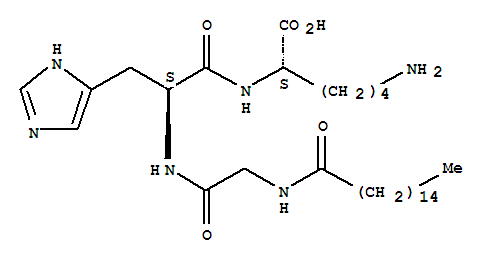Chemical Property of Palmitoyl oligopeptide
Edit
Chemical Property:
- Boiling Point:913.0±65.0 °C(Predicted)
- PKA:3.16±0.10(Predicted)
- PSA:179.30000
- Density:1.105
- LogP:5.60590
- XLogP3:3.2
- Hydrogen Bond Donor Count:6
- Hydrogen Bond Acceptor Count:7
- Rotatable Bond Count:26
- Exact Mass:578.41556884
- Heavy Atom Count:41
- Complexity:738
- Purity/Quality:
-
98% *data from raw suppliers
PalmitoylTripeptide-1 *data from reagent suppliers
Safty Information:
- Pictogram(s):
- Hazard Codes:
- MSDS Files:
-
Useful:
- Canonical SMILES:CCCCCCCCCCCCCCCC(=O)NCC(=O)NC(CC1=CN=CN1)C(=O)NC(CCCCN)C(=O)O
- Isomeric SMILES:CCCCCCCCCCCCCCCC(=O)NCC(=O)N[C@@H](CC1=CN=CN1)C(=O)N[C@@H](CCCCN)C(=O)O
-
Description
A peptide is two or more amino acids joined together and is the building block of protein. Peptides fall into three main categories: signal peptides, carrier peptides, and those that inhibit nerve signals. Signal peptides, like palmitoyl tripeptide-1, act as messengers to cells, which trigger collagen synthesis, which then increases skin firmness.Palmitoyl tripeptide-1 is a small three amino acid signal peptide with the amino sequence of glycine-histidine-lysine (GHK). GHK is attached to palmitic acid (a fatty acid) to increase its skin penetration and oil solubility. Pal-GHK is a form of the extracellular matrix-derived peptide GHK containing palmitic acid , which allows it to penetrate the stratum corneum to the epidermal and dermal skin layers. Pal-GHK (0.5 μM) increases collagen synthesis in human skin fibroblasts in vitro. It reduces collagen degradation ex vivo in patient-derived human skin samples irradiated with UVA light when used at a concentration of 6 ppm. It has been used with the zwitterionic surfactant C12 dodecyldimethylamine oxide (C12DMAO) to study self-assembly of the mixture into aggregates, ribbons, and nanobelts. Pal-GHK has also been used as an internal standard for the quantification of pal-KTTKS in anti-wrinkle creams by LC-MS/MS.
-
Uses
Palmitoyl Tripeptide-1, has shown to have effects on on collagen, fibronectin, hyaluronic acid synthesis in human dermal fibroblasts, and thus can be used in preparation of antiaging cosmetic creams.
-
Clinical Use
Applying palmitoyl tripeptide-1 directly to your skin tells the cells to make more collagen, stimulating new collagen production. It requires at least one month or more to begin to see visible changes from new collagen with maximum results visible after 3 to 4 months. Erin Gilbert, MD, FAAD, Ph.D., and board-certified dermatologist and neuroscientist, continues: "Peptides can be included in serums, moisturizers, and masks," Gilbert explains. "They are also included in some topical serums used after micro-needling or superficial laser procedures to increase the penetration of the peptide and help the skin recover from the procedure."



